Panther Creek, Washington

Copyright © 2003, Oregon Kayaking.
No part of this page may be reproduced, linked, or copied without the
express written
permission of the Oregon Kayaking Webmaster.
Panther Creek will surprise you if you aren't careful- the guidebook's listing of 112 fpm average gradient is misleading as most of that is lost in the last mile. There is a bridge that marks the beginning of the steep stuff, so if you are having troubles on the class II-III section above the bridge, get out while you can! (The bridge is also a great alternate put-in for those who wish to avoid the first four miles of annoying, woody class II-III.) The steeper, lower mile is basically an easier version of the 'Getting Busy' section on the Little White, so keep that in mind if the creek is really high... Also, this creek is always combined with a run down Lower Wind River, so be sure you allow time for the portage(s) on that run as well.
Pete and I put in on Panther Creek and paddled four miles of boring, woody
class II-III and were utterly confused. We remembered reading in the
guidebook that Panther had an average 112 fpm gradient over five miles, so
we started to get a little confused as we neared the four mile mark. We
hit
the roadbridge at mile four and I said to Pete: "Ok, Panther is a
tributary of the Wind, right?" Pete nodded. "and the Wind flows through a
300 foot deep canyon, right?" Pete nodded. "And we've just paddled four
miles through flatlands on incredibly boring class II , right?" Pete
nodded. "So this creek is about to drop down over two hundred feet through
a canyon wall, right?" Pete nodded. "Looks like kickoff time..." I said.
The creek was at medium flows after a full night of rain, and as
we began to descend into the canyon the gradient suddenly jumped by a
factor of ten to almost 300 fpm and suddenly we found ourselves faced with
a non-stop series of steep boulder gardens that rivaled the Miracle Mile,
except the creek bed was much more narrow and constricted. All of this
stacked up to form a long series of big drops that required scouting. Many
of the
rapids would have been very difficult to portage, though we did portage
one large double drop just below the bridge.
Pete scouting some of the initial drops, which are blinder and narrower
than the rapids downstream.
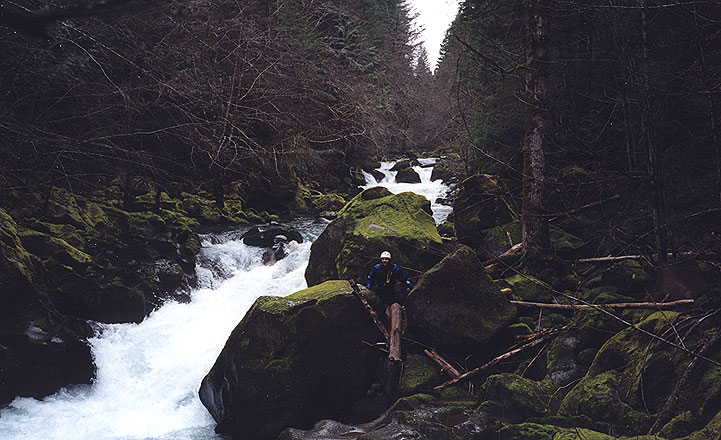
This rapid has a significant boulder sieve on the river-right side. If
you mess up in the short ledge in the background you could end up in it...
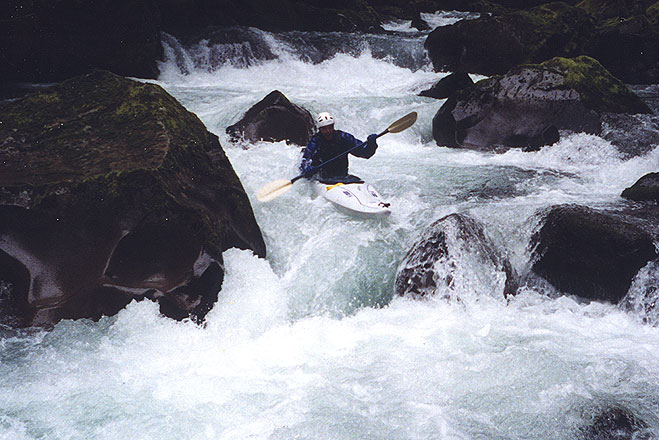
The second gnarliest moment of the day for me came when we arrived at a drop which poured over a boulder ledge. The main flow plowed against the right wall and into a violent churning eddy against a rock outcropping. This one was very difficult to scout, so we peered down into the chute as best we could and Pete opted to go first. He nailed the line, and then it was my turn. I ran the difficult lead in no problem, then got pushed to the right. I had too little speed and not enough left angle when I boofed and I dropped into the big hole and got surfed to the right into the U shaped depression in the wall. (Pete, watching from the pool below, said I disappeared for a long three count.) I got stern squirted and splatted against the wall for a few seconds before I spun myself off. I managed to stay upright and ran the rest of the drop ok. Actually, neither of us rolled all day, which was good because it would probably been pretty painful.
Here pete drops into chute against the right wall. The incut part of the wall where I got splatted is to his immediate right.
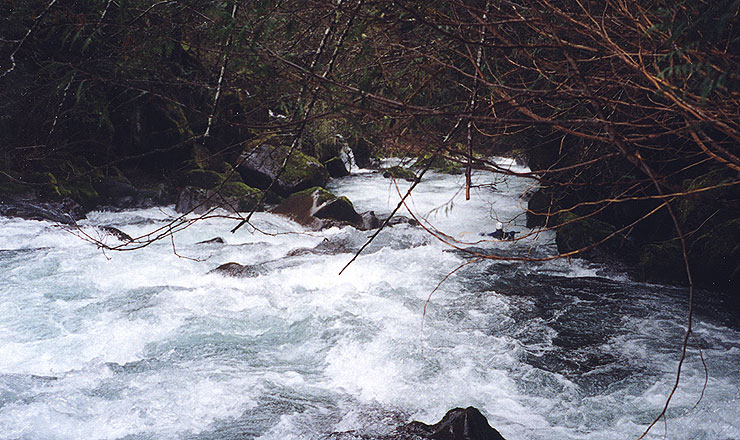
Next it was my turn to probe, so I ran a short lead in to another tough boulder garden that had the entrance blocked by a boulder sieve. We could see that the creek was flowing through several five foot wide slots between boulders. Immediately below the boulders water was shooting up in an alarming fashion. The plan was to catch a tiny eddy on the right because this was the only side we could scout or portage on if necessary. I ran the lead in, came in fast and tried to catch the tiny one boat eddy above the sieve. I had too much speed, and the eddy was much smaller than it had looked from upstream. I blew out of the eddy and was now backwards, sliding into the sieve, which was roaring hungrily behind me.
Pete was freaking out upstream as I reached down deep and attained back
upstream away from the sieve (don't ask me how, to this day I don't know
how) I pulled off this totally sketchy ferry across the creek and caught
another, larger eddy against the canyon wall. After watching my
horrible line Pete came down
and caught the eddy against the wall and said calmly, "Nice plan B."
Pete, hole-bashin' on Panther..
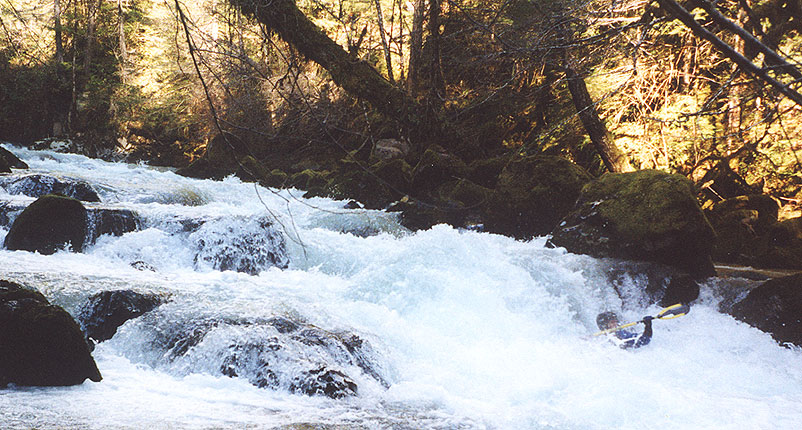
Pete cruises down the largest single rapid on Panther Creek
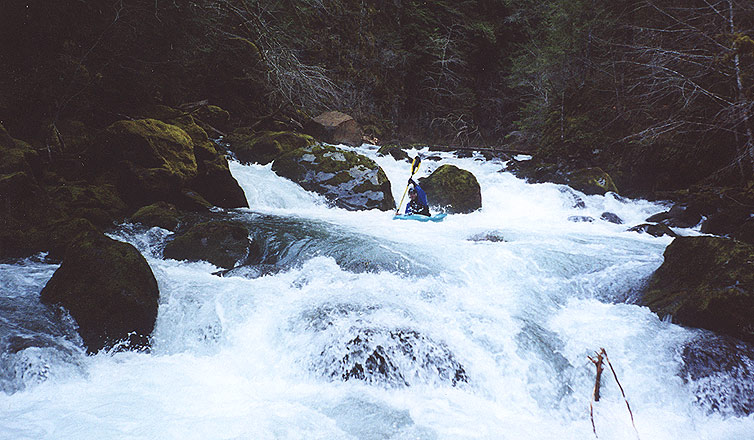
A nice upstream view..
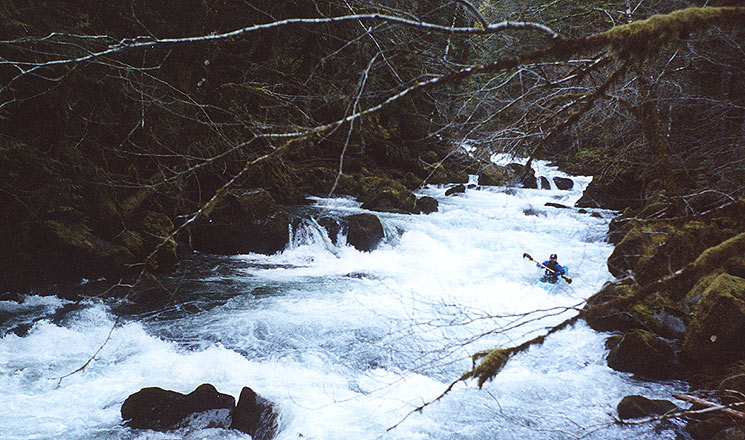
The view downstream on the final approach to the Wind River

Eventually we rounded the corner and we could see the Lower Wind River far
below, with only one more steep boulder garden to go. We did another long
scout and blasted down the last two hundred yards and hit the Wind, which
was running medium high and felt like an ocean in comparison.
FLOWS: Panther only runs after heavy rainstorms and in the Spring during the snowmelt. There is a
paddlers
gauge under the put-in bridge (assuming you only run the last, or
steepest, mile down into the Wind. I don't know about the put-in detailed
in the Bennett guide). The
photos on this site where taken in the 18-21 inch range on that gauge.







